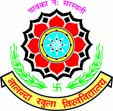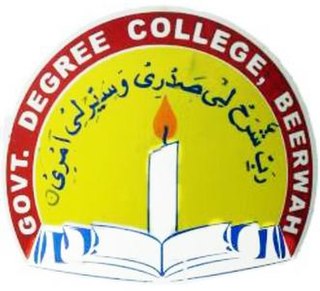
Buxi Jagabandhu Bidyadhar Autonomus College, better known as BJB Autonomous College, is a college in Bhubaneswar in Odisha, India that offers courses at primarily the higher secondary and undergraduate levels.

Pachhunga University College (PUC) is a public institute in Aizawl, Mizoram, and the only constituent college of Mizoram University, a central university established by an Act of Parliament of India. Founded in 1958 as Aijal College, it is the oldest and largest college in Mizoram, by enrolment and campus size. It started with intermediate of arts courses, and later expanded to bachelor degrees in arts, commerce and science. With the opening of master's degree courses in Mizo, philosophy and life sciences, it became the first postgraduate college in Mizoram.

Indira Gandhi National Open University known as IGNOU, is a Central Open Learning University located at Jayantpali village of Mahendergarh haryana, India. Named after former Prime Minister of India Indira Gandhi, the university was established in 1985 with a budget of ₹20 million, after the Parliament of India passed the Indira Gandhi National Open University Act, 1985. IGNOU is run by the central government of India, and with total active enrollment of over 4 million students, claims to be the largest university in the world.

Government T. Romana College is a degree college affiliated to Mizoram University, located in Republic Vengthlang, Aizawl, Mizoram, India. The College was established in 1992 as a private institution, upgraded to grant-in-aid status in 2003 and provincialised in 2008.It is graded B by NAAC.

The Government Champhai College is a government university college associated with Mizoram University, located in Champhai, Mizoram, in India. Established as a private college in 1971 by the philanthropists of Champhai town and neighboring villages, the founders' objective was providing collegiate education to the students of this remote hilly tribal town near the international border of India with Myanmar.

Nalanda Open University (NOU) is a university at Patna in Bihar state, India. It is the only university in Bihar providing education through distance and open education. Nalanda Open University Degree/Diploma /Certificates are eligible for higher studies, public & private sector employment and service promotions. It is recognized by University Grants Commission (UGC). It is a member of Association of Indian Universities which is mainly concerned with the recognition of Degrees/Diplomas awarded by the Universities in India, which are recognized by the University Grants Commission, New Delhi, and abroad for the purpose of admission to higher degree courses in Indian Universities. It is an open university which means that it follows an open-door academic policy and is open to everyone for admission with minimum requirements.

Salesian College, Darjeeling (SC) is a Government recognized, minority educational institution of the Catholic Church, run by Salesians of Don Bosco (SDB), Kolkata Province where over 1800 students do their Arts/Humanities, Commerce, Science and Professional Courses under the North Bengal University .
Government Saiha College is the only college in Saiha district of Mizoram, northeast India. It is the first college in southern Mizoram. It was established in 1978 as a result of public demand, and recognised by the Government of Mizoram in 1979. It started as only arts college. It is now under the jurisdiction of the Mizoram University and under recognition of the University Grants Commission (India).
Government Aizawl West College is an educational institution located in Dawrpui Vengthar, Aizawl, Mizoram. It is currently affiliated with Mizoram University.

Education in Mizoram consists of a diverse array of formal education systems ranging from elementary to university, from training institution to technical courses. The Government of India imposes mandatory education at least up to the basic level. For this public schools are made free of fees, and provided with free textbooks and school lunch.

Lunglei Government College is the biggest college in the town of Lunglei, Mizoram. It is graded B++ by NAAC. Talks are underway now with UGC to set up Mizoram University campus in Lunglei Government College campus, thus making it a constituent college of Mizoram University like Pachhunga University College. The College has 807 students and 61 Faculty.

Ponnaiyah Ramajayam Institute of Science and Technology (PRIST) is a private and deemed university in Vallam Thanjavur, India. The institute offers undergraduate and postgraduate courses in Engineering, Science, Education, Management, Arts, and Law, as well as research programmes. The institute has campuses in Trichy, Kumbakonam, Puducherry, Chennai, and Madurai. Ponnaiyah Ramajayam Institutions is a group of colleges in Tamil Nadu.

Government Lawngtlai College is the only institute of higher education in Lawngtlai district of Mizoram, northeast India. It was established by public demand in 1980 in Lawngtlai. It became a government college under the Government of Mizoram in 1988.
The Mizoram College Teachers' Association (MCTA) is a governmental, non-political and non-profit organisation for college teachers under the Government of Mizoram, India. It was established by a conference of college teachers on 7 September 1979 at Aizawl, which became its headquarters. The organisation is recognised by the Government of Mizoram, and consists of 21 government colleges and 1 grant-in-aid college.
Government Hnahthial College is the only institute of higher education in Hnahthial, Hnahthial district of Mizoram, Northeast India. It was established in 1979 in Hnahthial. It became a government college under the Government of Mizoram in 1981. Under governmental organisation of Mizoram, it operates as a branch of the Mizoram College Teachers' Association.

Government Aizawl North College is an educational institution located in Ramhlun Venglai, the northern part of Aizawl, Mizoram. The college is affiliated with Mizoram University As of 2014, it has 1120 students. The college's principal is Prof. S. Haukhanlian Mate. The College at present has 1,309 students, 28 teachers and 12 non-teaching staff.

Amar Singh College,(Urdu, امر سنگھ کالج سرینگر) Srinagar, is an academic & professional college in Kashmir. It is the second oldest college in the Kashmir Valley after Sri Pratap College.

The Government Degree College, Beerwah also known as GDC Beerwah, is a University Grants Commission autonomous coeducational degree college in the state of Jammu and Kashmir located on 60 Kanal campus in Beerwah 30 kilometres (19 mi) from Srinagar. The College is affiliated with the University of Kashmir.

Kamalanagar College is a college in the town of Kamalanagar, Mizoram.

Aizawl is the capital of the state of Mizoram in India. Aizawl was officially established on 25 February 1890. With a population of 293,416, it is the largest city in the state. It is also the centre of administration containing all the important government offices, state assembly house and civil secretariat. The population of Aizawl strongly reflects the different communities of the ethnic Mizo people.















